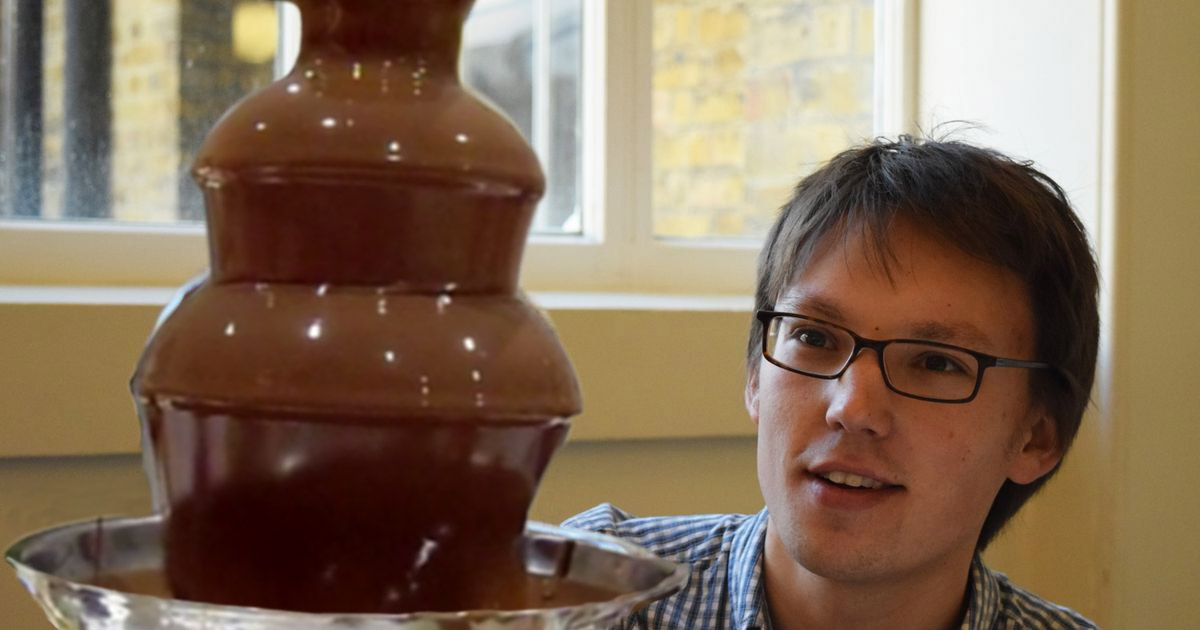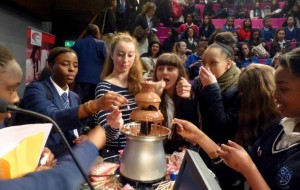
The fluid dynamics of chocolate fountains
In my masters year I worked on a project, The fluid dynamics of chocolate fountains, with Professor Helen Wilson at UCL, which was published in the European Journal of Physics in December 2015.
The maths of chocolate fountains outreach talk
Delicious, obviously, but would you believe they’re full of maths? In my most popular pop-maths talk, we find out how to make predictions for chocolatey flows, and then work out (a) whether we can use other types of chocolate, (b) whether we could make a pioneering ketchup fountain, and (c) why chocolate fountains fall inwards, not directly downwards.
Although adapted to fit the audience, everything I present here comes from my master’s project, which was published in a research journal in 2015, so it’s genuine applied maths research! And I always bring the fountain to every talk. Topics brought in include:

Image: Luciano Rila
- good and bad models for everyday things (and how to tell between them),
- how mayonnaise and cornflour paste react in opposite ways when hit,
- the link between these liquids and the graphs of $y = x^n$ for different $n$,
- why teapots drip backwards (and how we could fix this).
Good for all ages, as I showcase the scientific method. GCSE students enjoy seeing the power of the power law. For A-level students, I reveal the secrets of fluid mechanics, and show why it’s harder than the mechanics they see at A-level.
Works best as an hour-long talk, with some time for eating chocolate afterwards.
Research paper
Abstract: Chocolate fountains are popular features at special events. But why do they never use white chocolate? Would they work with water? And why, when the chocolate falls, does it fall slightly inwards? In this most delectable of studies, we investigate the trade-off between accuracy and simplicity in models used by commercial chocolatiers. In different geometries of the fountain, we solve the governing equations—mostly analytically—and compare these results with observations from our own fountain experiments. We find that, with some limitations, our models are in fact good for a number of non-Newtonian fluid problems. Marshmallows are, sadly, not provided.
Published article (open access):
The fluid dynamics of the chocolate fountain.
European Journal of Physics 37 (1), 015803.
Some nice write-ups in the media:
- The Washington Post: Someone finally looked into the physics of chocolate fountains
- Daily Mail: The physics of a chocolate fountain: Curtains of melted goo pull inwards because of surface tension
- Smithsonian Institution: Chocolate fountains are great for physics lessons
- Irish Examiner: One student with a sweet tooth finally explains the magic behind chocolate fountains
- PopSci.com: A chocolate fountain can introduce kids to complex physics
- Birmingham Mail: Chocolate fountain mystery: PhD student works out why liquid cocoa pours inwards
- UCL press release: Exploring the physics of chocolate fountains
And some interviews on the radio:
- BNR News Radio in the Netherlands: Als je van wiskunde geen chocola kunt maken, draai het dan om *
- Heart Breakfast with Ed & Rachel: Chocolate? It’s Good But What Else Can We Fountain?
* Guide to Dutch puns: In Dutch you can say “I cannot make chocolate out of something”. This means that you don’t understand it at all. So, the headline reads: If you cannot make chocolate out of maths, do the reverse. And ‘spanning’ (= tension) can also mean the state of being excited. (Or it can mean stress, as Google suggests). Thanks to Mark Beekhuis at BNR for translating!
Older versions of the project:
- The fluid dynamics of chocolate fountains: synopsis
Latest version: 14/07/2012 - The fluid dynamics of chocolate fountains: full MSci project
Latest version: 20/03/2012. This contains some mistakes which have been fixed in the published paper, but also contains some more problems we looked at, and some more explanation of many of the steps.